Are you a Quiet Speculation member?
If not, now is a perfect time to join up! Our powerful tools, breaking-news analysis, and exclusive Discord channel will make sure you stay up to date and ahead of the curve.
Modern is often referred to as a "wide open" format, where deck choice is based more on preference than the "correct metagame choice." This mentality can at times lead to poor decisions based around pet cards, favorite strategies, or simply stubbornness. It can overwhelm any player looking to prepare for tournaments without a preset idea of what they want to play. And for new players who are unfamiliar with the format, it can be downright daunting.
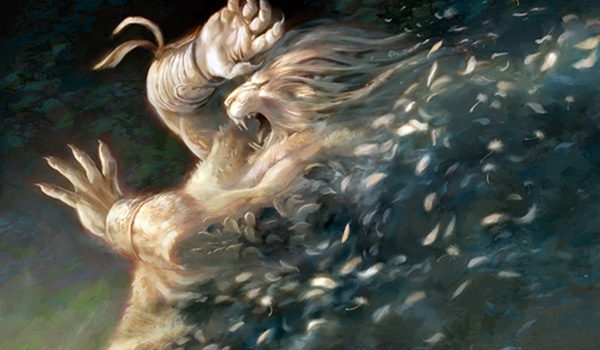
But there's more structure to Modern than appears at first glance. There are a ton of decks in Modern, it's true, but nearly all of them can be thought about in the context of more general archetypes. At the end of the day Modern follows the same basic patterns as the rest of Magic, and can be broken into controlling, aggressive and combo-based strategies.
In a format with so much depth these strategies are bound to splinter into innumerable combinations and slight gradations, and certainly there's a lot of nuance when approaching any individual deck with a plan to beat it. But there isn't enough mainboard or sideboard space to just jam one silver bullet against every deck---if we include all the Tier 3 decks from Sheridan's latest Top Decks metagame breakdown, there are 35 different ones to prepare for! In this context it's crucial to craft a broad-strokes game plan for each overarching strategy. Your card choices, both in the main and sideboard, need to be useful against a wide range of specific archetypes.
Today I'm going to break down each of the overarching pillars of Modern and discuss how to exploit their weak points. I'll offer advice on general approaches to beating them, and use my Grixis Delver deck (posted below for reference) for a more concrete example. I'll try to touch on some of the details regarding specific decks, though not exhaustively given the raw volume out there. Here we go!
[wp_ad_camp_1]
Grixis Delver, by Ryan Overturf (5th, SCG Indianapolis, 5/14/2016)
Control Decks
Here I'm including midrange decks, and this group forms a spectrum from more midrange (Jund) to full-on control (Jeskai Harbinger). What this class of decks share in common is the intention to kill or neutralize most or everything the opponent does. 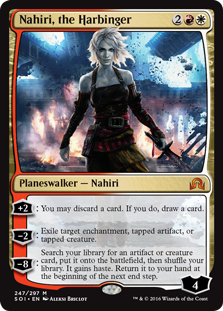 BGx certainly gets to turn the corner real fast, and sometimes comes out of the gates on the beatdown plan, but it's still largely an answer-based deck that looks to disrupt and control.
BGx certainly gets to turn the corner real fast, and sometimes comes out of the gates on the beatdown plan, but it's still largely an answer-based deck that looks to disrupt and control.
There have been many windows when control simply wasn't viable in Modern, though that is not the case currently. From Grixis and Jeskai Ancestral Vision decks, to the aforementioned BGx, to Ghostly Prison/Blood Moon decks and Lantern Control, there are many options available in this camp. I would even consider Grixis Delver to be somewhere on the controlling spectrum, though in a position where it's generally disadvantaged against other controlling blue decks.
When it comes to beating control decks, what you want are resilient win conditions, ways to stop them from burying you in card advantage, and reach to win outside of combat. Things like Bogles can put these decks in a position where their conventional answers look silly, though Grixis is forced to play the game on their terms.
Tasigur, the Golden Fang is the primary reason to play black in Grixis Delver, because it dodges Abrupt Decay and Lightning Bolt (though it does easily succumb to Path to Exile and Terminate). 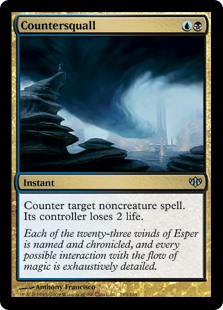 Countersquall is a huge upgrade in three-game sets against these decks, as it not only enables me to stifle their gameplan, but also provides some reach. Countersquall is a perfect example of a multipurpose tool that earns its sideboard slot over one-dimensional cards like Dragon's Claw.
Countersquall is a huge upgrade in three-game sets against these decks, as it not only enables me to stifle their gameplan, but also provides some reach. Countersquall is a perfect example of a multipurpose tool that earns its sideboard slot over one-dimensional cards like Dragon's Claw.
My build of Grixis Delver makes a major concession to the controlling matchup with Ancestral Vision. I just can't beat an Ancestral Vision deck without being able to board Delver out into something great, and these decks are pretty popular right now. As such, I am currently using four sideboard slots just for these decks. This is a significant commitment of resources, one I wouldn't make if I felt my game one matchup against these decks were close.
So-called "sticky" creatures also excel against the controlling decks of the format. While Voice of Resurgence doesn't take up as many maindeck slots as it once did, it and Kitchen Finks will force your control opponents to draw specific answers or end up behind on cards. Realistically any creature that generates card advantage will be great in these matchups, and you'll often 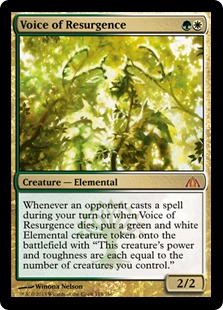 see Chord of Calling decks play to Reveillark and Eternal Witness rather than going all-in on the combo in the face of removal spells.
see Chord of Calling decks play to Reveillark and Eternal Witness rather than going all-in on the combo in the face of removal spells.
Big Mana Decks
Tron, Valakut, and Eldrazi are the most prominent examples of the big mana decks. While they come in many flavors the principle is the same---these decks go "over the top" of the rest of the Modern format with the biggest, most powerful plays. Given recent printings, these things also frequently end up being more resilient. World Breaker and Ulamog, the Ceaseless Hunger have made trying to interact with these decks nearly impossible, and Valakut, the Molten Pinnacle has always been great at winning longer games when both lands and spells are good topdecks.
A lot of players gravitate towards Blood Moon for these matchups, though for a narrow haymaker it's surprisingly ineffective. Realistically, outside of quick wins these decks don't struggle against much. Tron can build up to casting Wurmcoil Engine and World Breaker relatively easily unless you're  actually destroying lands or winning the game.
actually destroying lands or winning the game.
Land destruction spells are so narrow, and my deck chooses to focus on the "winning the game" side of things. I have cards that I bring in against these decks to slow them down, like Spell Pierce, though mostly these are the decks that cause me to maindeck Delver of Secrets. These decks can draw out of a lot of bad situations and their end-game tends to be difficult to interact with. The only surefire way to get out alive is to deal them lethal damage. Speed is by far the most important factor battling big mana decks, and if you're casting things like Blighted Agent you don't have to worry about any dedicated slots for these matchups.
Stony Silence is surprisingly effective against Tron while also hosing Lantern Control and Affinity, though unless your deck is good at killing the other big mana decks or is also weak against the other artifact decks, it may not be what you're looking for. This is actually a spot where Nahiri, the Harbinger has given some slower decks more play, as Nahiri will enable you 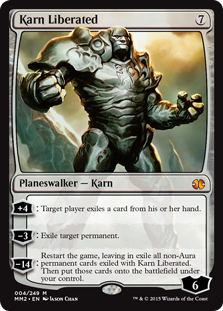 to cheese a game with Emrakul when backed by minor disruption.
to cheese a game with Emrakul when backed by minor disruption.
You'll often see Crumble to Dust in sideboards, and in decks that also feature more efficient disruption it can be a back-breaker. Just remember that tossing Crumble in your board doesn't solve these matchups on its own. It does cost four, after all, and sometimes you're already getting hit by Primeval Titan or Karn Liberated at that point. It's in these big mana matchups more than anywhere else in Modern where a haymaker realistically won't win you the game, and the coherence of your game plan will be all that matters.
Aggressive Decks
This is easily the broadest category, and there's little overlap when it comes to beating Affinity, Zoo, Burn, Infect, Merfolk, and Bogles. There are ways to cheese a couple of these decks, such as having Ancient Grudge for Affinity or Kor Firewalker for Burn, though this is a group of decks where keeping things as generic as possible gives you the most 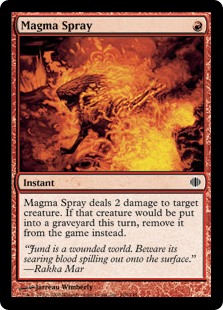 equity against the field. The most obvious tools for this purpose are the omnipresent Path to Exile and Lightning Bolt.
equity against the field. The most obvious tools for this purpose are the omnipresent Path to Exile and Lightning Bolt.
Short of Bogles, Magma Spray is a solid card to have against all of these decks. It's primarily in my sideboard because of Voice of Resurgence, but against any of these decks efficiently one-for-oneing them while you set up your gameplan is your best bet. Grixis Delver has enough game against these decks that I don't need any committed slots here, though for the most part you'll want to find a way to make your deck as lean as possible so as not to just get run over. Remember, if you worry too much about just beating Affinity, you may leave yourself with the wrong tools to beat Merfolk. Keep it generic unless one of these archetypes specifically gives you fits.
The one aggressive deck that my 75 makes a specific concession to is Bogles. I would not have Engineered Explosives in my sideboard if not for Slippery Bogle. Even still, I picked a card that has other applications. Something like Self-Inflicted Wound might be the best card just for this matchup, but Explosives can also randomly tag an Ensnaring Bridge or a token army to offer the most overall utility.
 When approaching these matchups, you need to identify how much time you need to buy in order to win. For Grixis, you just need to one-for-one them constantly. For a deck like Ad Nauseam, your Angel's Graces will be able to buy you all the time you need, possibly supplemented by some sideboard Darknesses. Timely Reinforcements is another powerful option against many of these decks, though it all comes down to how quickly your deck is able to win and how much you need to disrupt your opponent to accomplish this. For example, Darkness wouldn't make any sense in Grixis as it wins the game slowly and cares about card advantage, and Lightning Bolt wouldn't make any sense in Ad Nauseam as it can leverage Fogs to stay alive just long enough to combo.
When approaching these matchups, you need to identify how much time you need to buy in order to win. For Grixis, you just need to one-for-one them constantly. For a deck like Ad Nauseam, your Angel's Graces will be able to buy you all the time you need, possibly supplemented by some sideboard Darknesses. Timely Reinforcements is another powerful option against many of these decks, though it all comes down to how quickly your deck is able to win and how much you need to disrupt your opponent to accomplish this. For example, Darkness wouldn't make any sense in Grixis as it wins the game slowly and cares about card advantage, and Lightning Bolt wouldn't make any sense in Ad Nauseam as it can leverage Fogs to stay alive just long enough to combo.
Combo Decks
These decks come at you from a lot of different angles: Scapeshift, Abzan Company, Ad Nauseam, Storm, etc. Counters and discard spells will serve as generic answers to most combo decks and your removal for the aggressive decks should be good against Abzan Company, though mostly you'll want to remove your opponent from the game in the same vein as big mana decks.
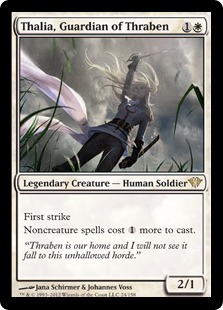 The combo decks in Modern attack from too many angles, so unless you're a blue or black deck you won't really have easy ways to adapt. This is one category where you really need to know which combo decks, if any, are bad matchups for you and decide where to commit full sideboard slots. As mentioned above, my Magma Sprays are for Abzan Company, though they conveniently play well against the aggressive decks.
The combo decks in Modern attack from too many angles, so unless you're a blue or black deck you won't really have easy ways to adapt. This is one category where you really need to know which combo decks, if any, are bad matchups for you and decide where to commit full sideboard slots. As mentioned above, my Magma Sprays are for Abzan Company, though they conveniently play well against the aggressive decks.
Thalia, Guardian of Thraben is likely the most broad white card for hating on combo decks, though she is typically featured in the maindeck. The green and red options mostly just boil down to killing your opponent before you die to things like Become Immense and burn spells.
On the topic of sideboarding with Burn, you want to make sure you don't go overboard in assessing your matchup against combo decks, or really any deck in the field. The number one way I see red decks lose in Modern is when they draw excessive sideboard cards that don't deal damage to their opponent. The only time you should consider going deep on sideboarding is when you're heavily unfavored to burn them out before they kill you. Otherwise your sideboard cards are going to hurt you more than your opponent.
An anecdote. The other day Merfolk aficionado Corbin Hosler tweeted asking about the rules interaction between Lightning Storm and Kira, Great Glass-Spinner.
Lightning Storm targets me, I redirect to Kira. Countered even if the Storm's target is switched off Kira after? @ahalavais @Silverspade10
— Corbin Hosler (@Chosler88) May 25, 2016
Turns out the answer is yes. This is a really awesome way to utilize a sideboard slot to beat both control decks and that one specific combo deck. Finding cards with cross applications like this can be a huge boon.
On Not Beating Everything
There's one matchup for Grixis where I currently shrug my shoulders: the graveyard decks. These fall somewhere on the aggro-to-combo spectrum. I haven't played against the new Dredge lists with Delver yet, but I'm sure they're bad matchups.
 I didn't expect them to be popular in Indianapolis, and given that I had no idea if tossing a couple graveyard hate spells in my sideboard would matter---or if I'd even play against these decks---I just didn't bother. Sometimes you just have to commit to dodging a matchup, and if you don't expect to play against a specific deck there's no reason to specifically target it with your sideboard when the slots are at a premium.
I didn't expect them to be popular in Indianapolis, and given that I had no idea if tossing a couple graveyard hate spells in my sideboard would matter---or if I'd even play against these decks---I just didn't bother. Sometimes you just have to commit to dodging a matchup, and if you don't expect to play against a specific deck there's no reason to specifically target it with your sideboard when the slots are at a premium.
There are some sideboard slots against these decks that apply slightly more broadly. Grafdigger's Cage, for example, is quite good against Collected Company. Relic of Progenitus can also be reasonable against decks with a small number of graveyard uses while also replacing itself. Just be careful not to do something foolish like bring in Rest in Peace against a deck just because it has Snapcaster Mage. I can't tell you how many times my opponents have cast a sideboard card and it felt more like they mulliganed.
There's a lot going on in Modern, and it's unlikely that you'll be prepared for every deck in the format. But with clever building and by thinking of your sideboard as a way to craft gameplans rather than a spot for some generic haymakers, you can be prepared for most of it.
Thanks for reading.
-Ryan Overturf
@RyanOverdrive on Twitter





I’m glad to see that finally someone understands the real nature of Jund. Not only the aggressive, but the control-reactive one. Too many people can’t see it because the absence of counterspell.
Great article in general in any case. Keep it up.
You know, classifying “big mana” as its own archetype makes a lot of sense. Most of those decks do play pretty similarly to each other, and are vulnerable to similar pieces of hate. Everything else I mostly found myself nodding along with. Keep up the good work!
Nice article! The vast number of decks in Modern has been rather daunting for me as a relative newbie to the format. I’m also not very good at sideboarding in general, so as an exercise to force me to both develop my skills and deal with Modern’s diversity, I gave myself a rule: no more than two copies of any given card in my sideboard. That means I can’t just jam four Crumble to Dust against Tron and then have 11 slots left to deal with everyone else, or otherwise count on a playset of a single “silver bullet” for any given deck. That forced me to think of additional cards to board in against any given deck (since “Plan A” would at most be two cards and therefore couldn’t be relied on in isolation), which required looking past the obvious choices at other things that can make an opposing deck stumble.
For example, instead of my Tron plan being to bring in the Crumbles and pray, I might bring in a mix of Stony Silence, Pithing Needle, Fulminator Mage, and Surgical Extraction. Now I can get an edge from lots of different angles depending on which card(s) I draw, and I actually have a better chance of getting at least one sideboard card than I did with the Crumble plan. Meanwhile, every one of those cards has applications elsewhere: Stony Silence against Affinity (and others), Needle against Nahiri or Merfolk, and so forth.
I’ve been really happy with the results so far.
The only hard and fast rule that I follow is to be wary of hard and fast rules. Restrictions breed creativity, though be mindful of when you want to break that rule. Moderation in all things- even moderation.
Then shouldn’t that be “Moderation in *some* things”?
But yes, I agree. My self-inflicted rule is temporary.
That just doesn’t sound anywhere near as profound.
Good article. The Modern definition of control is different from the definition of control in other formats, and that doesn’t have to be a bad thing. I personally really like Jund and Jeskai in Modern.
Glad to see you contributing to this website, Ryan Overturf. I like your work.
“Just be careful not to do something foolish like bring in Rest in Peace against a deck just because it has Snapcaster Mage”
A lot of Snap decks don’t have any traditional card advantage or even 2-for-1’s outside of Snappy himself. If you’re playing aggro against Jeskai it makes sense to board out your own dead removal for some grave hate to keep from getting snap-helixed or electrolyzed out of the game. I don’t mind taking a mulligan if it means cutting down an opponent’s removal and main source of card advantage.
If your sideboard is well constructed and you’re bringing dead cards out, then yes, you are correct. The act of bringing RIP in itself is not great, though there are parameters where it is correct.